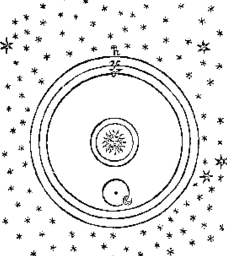The "new philosophy"
Neither Copernicus nor Digges got it all right, for they believed that the orbits of the planets were circular*, with the sun in the centre.
Copernicus' system was still clumsy when it came to the prediction of the movements of the planets. Johannes Kepler, in 1609, made the further discovery of the elliptical orbits of the planets--earth included--and at last the system made complete mathematical sense.
Galileo and the "new philosophy"
Galileo, using a new toy, the telescope, saw the moons revolving around Jupiter (they would have broken any crystalline sphere), and so the evidence accumulated. Knowledge of the Copernican system spread rapidly, despite the attempts of the Catholic Church to prevent* it, and by 1611 Shakespeare's contemporary, the poet John Donne (1572-1631), could sum up an attitude of the age in the much-quoted lines:
And new philosophy calls all in doubt,
The element of fire is quite put out;
The sun is lost, and the earth, and no man's wit
Can well direct him where to look for it . . .
' Tis all in pieces, all coherence gone,
All just supply, and all relation . . .
("An Anatomy of the World" [c. 1612] )
Footnotes
-
Wheels within wheels
The result of assuming circular orbits for the planets was that the awkward expedient of "epicycles"--circles on the circles that themselves rotated--had still to be adopted.
-
Science vs. religion
In the year of Shakespeare's death, 1616, the Catholic Church denounced the Copernican system and the support that Galileo's writings had given it. Later he was forced to deny his theories, and was put under house arrest.
